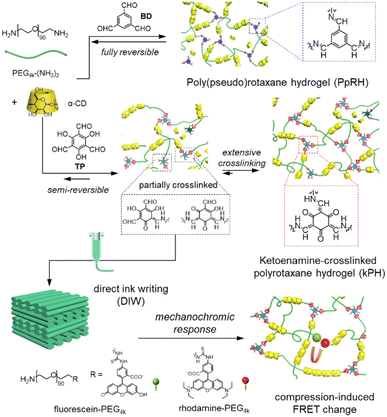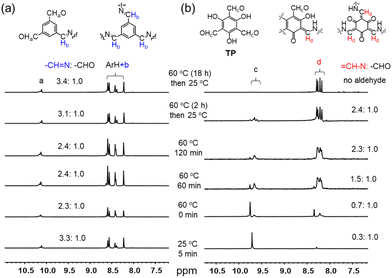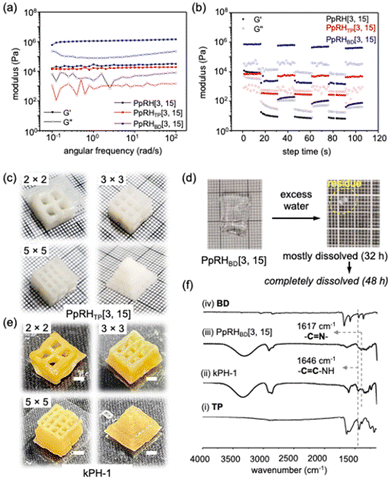3D-printed ketoenamine crosslinked polyrotaxane hydrogels and their mechanochromic responsiveness†
Dan
Zheng‡
 ,
Miao
Tang‡
,
Miao
Tang‡
 and
Chenfeng
Ke
and
Chenfeng
Ke
 *
*
Department of Chemistry, Dartmouth College, 41 College Street, Hanover NH 03755, USA. E-mail: Chenfeng.Ke@dartmouth.edu
First published on 24th April 2023
Abstract
A ketoenamine-based dynamic covalent crosslinker was introduced to α-cyclodextrin-based polypseudorotaxanes, forming viscoelastic hydrogels for direct-ink-write 3D printing. The irreversible enol–keto tautomerization imparts high chemical stability to the extensively crosslinked polyrotaxane hydrogels, which showed mechanochromic responsiveness in the presence of the integrated fluorophores.
Dynamic covalent chemistry (DCC)1,2 has been integrated into polymer designs as an enabler for self-healing3–5 and recycling properties.5 In these DCC networks, dynamic covalent bonding motifs, including imine,6–10 oxmine,11 boronic ester,12,13 Diels–Alder adduct,14–17 disulfide,18,19 and hydrazone,20–23 can form, dissociate, and exchange reversibly upon external stimuli.24–27 As such, DCC-based polymers have been developed as shape-morphing4,16 and self-healing materials.11,12,17,28 Among these DCC reactions, reversible imine condensation has been used to construct direct-ink-write (DIW) 3D printing materials,22,28 because the reversibility of imine bond formation and dissociation can facilitate the shear-thinning and self-healing properties required for DIW.29,30 However, the chemical stability of imine linkages in these viscoelastic hydrogels is often concerning due to the abundance of ambient water favoring the equilibrium towards the starting materials.7,31 On the other hand, α-cyclodextrin (α-CD)-based polypseudorotaxanes have also been introduced as viscoelastic hydrogels for DIW,32–36 where the micro-crystalline domains formed between the polypseudorotaxanes serve to noncovalently crosslink the network.36 The state-of-the-art polypseudorotaxane hydrogels utilize photo-crosslinking to afford 3D-printed polyrotaxanes, and they exhibited a variety of stimuli-responsive properties such as solvent-,32 pH-,33 thermo-,34 and moisture-responsiveness.36 While photo-crosslinked hydrogels have been widely studied, hydrogels that can be crosslinked without the need of photo-initiators and light irradiation will simplify the technical prerequisites for deployment, especially in biomedical environments.
In this work, we integrate the dynamic imine network with the polypseudorotaxane hydrogel design, and expect the dual-crosslinked hydrogels to possess improved viscoelasticity for DIW 3D printing while eliminating the need for photo-crosslinking, removing the concern of insufficient crosslinking due to limited light penetration.32–35 Herein, we introduce two dynamic crosslinkers, namely, 1,3,5-benzenetrialdehyde (BD) and 1,3,5-triformylphloroglucinol (TP) to form DCC networks with α,ω-diamino-polyethylene glycol (PEG4k-(NH2)2). PEG4k-(NH2)2 also serves as the axle for α-CD threading, forming a non-covalently crosslinked polypseudorotaxane network (Fig. 1). Different from the highly reversible imine-crosslinked network formed by BD and PEG4k-(NH2)2, the reaction of TP with PEG4k-(NH2)2 generates a more stable network due to the semi-reversible imine-to-ketoenamine tautomerization.37–40 In the presence of α-CDs, the polypseudorotaxane hydrogels crosslinked by these dynamic crosslinkers show different viscoelastic features. After extensive crosslinking, we discovered that the ketoenamine-based hydrogels showed good chemical stability against extensive washing, while the imine-crosslinked poly(pseudo)rotaxane hydrogels dissolved completely. After further appending rhodamine B and fluorescein moieties to the PEG axles, the generated ketoenamine-based polyrotaxane hydrogel showed mechanochromic response upon compression as a result of the Förster resonance energy transfer process.41,42
 | ||
| Fig. 1 Graphical illustration of the construction of 3D-printed polyrotaxane networks connected via dynamic covalent crosslinkages. | ||
In our design, we chose a medium chain-length PEG4k (![[M with combining macron]](https://www.rsc.org/images/entities/i_char_004d_0304.gif) n = 4000 Da) as the axle because long-chain PEG-based hydrogels are difficult to be filtered out by human kidneys.43 However, when an unfunctionalized PEG4k axle is mixed with α-CD, white precipitates or brittle hydrogels are formed at different concentrations due to the crystallization of α-CD-threaded polypseudorotaxanes.36 Hence, we introduced DCC networks to improve the viscoelasticity of these polypseudorotaxanes.
n = 4000 Da) as the axle because long-chain PEG-based hydrogels are difficult to be filtered out by human kidneys.43 However, when an unfunctionalized PEG4k axle is mixed with α-CD, white precipitates or brittle hydrogels are formed at different concentrations due to the crystallization of α-CD-threaded polypseudorotaxanes.36 Hence, we introduced DCC networks to improve the viscoelasticity of these polypseudorotaxanes.
To understand the reversible nature of the dynamic networks formed by PEG4k-(NH2)2 and crosslinkers BD and TP in water, time-dependent 1H NMR studies were performed at the same concentrations for the hydrogel formations in the absence of α-CD (Fig. 2). TP and PEG4k-(NH2)2 were synthesized according to previously reported methods.33,37 When BD and PEG4k-(NH2)2 were mixed together, the reaction proceeded rapidly (5 min) at room temperature to form imine linkages (Fig. 2a). When the sample was heated to 60 °C, the imine formation was slightly reversed. The reaction equilibrium was re-established when the sample was cooled to room temperature, and the imine-to-aldehyde ratio resumed to that before heating. In contrast, TP was largely unreacted in the mixture of TP and PEG4k-(NH2)2 at room temperature, and the reaction gradually proceeded at 60 °C (Fig. 2b). Two sets of aldehyde proton resonances were observed at 9.75 and 9.66 ppm, attributed to the unreacted and partially reacted TP, respectively. 2D NMR experiments (Fig. S5, S6 and S8–S10†) suggested that the proton resonances observed at 8.2 ppm are attributed to the ketoenamine moieties, and the population of imines is nearly negligible. After 18 h reaction at 60 °C, most TP had been converted to the ketoenamine linkages. These time-dependent 1H NMR studies suggest that the rate of the reaction between TP and PEG4k-(NH2)2 is much slower than that of BD and PEG4k-(NH2)2, and the ketoenamine network is much less reversible compared to the imine network.
In the presence of α-CD, the reactions of PEG4k-(NH2)2 and dynamic crosslinkers BD and TP were heated at 60 °C for 2 h and then cooled down to room temperature, affording a series of viscoelastic hydrogels. Due to the dynamic covalent crosslinking, these hydrogels contain polyrotaxanes and polypseudorotaxanes, some of which are interconvertible. Hence, we name these samples poly(pseudo)rotaxane hydrogels (PpRHs[a,b]), in which a and b are the weight percentages of the PEG4k-(NH2)2 and α-CD, respectively. At different ethylene glycol (EG) repeat unit to α-CD ratios (Tables S1 and S2†), PpRHs possess different viscoelastic properties in the rheological investigations (Fig. S15–S45†). When BD was used as the dynamic crosslinker, the elastic moduli of PpRHBD hydrogels ranged between 105–106 Pa at a wide range of EG/α-CD ratios (Fig. S33–S45†). For example, PpRHBD[3,15] possesses an elastic modulus G′ = 9 × 105 Pa in the angular frequency sweep (Fig. 3a), and excellent self-healing features in the step-strain studies (Fig. 3b). In comparison, PpRH[3,15] formed by bare PEG4k and α-CD has an elastic modulus of 2.5 × 104 Pa with a poor self-healing profile (G′ = 1.1 × 102 Pa after five cycles of step-strain sweeps, Fig. 3a and b). Furthermore, the PEG4k-(NH2)2 and TP reaction mixture at the same concentration as the PpRH[3,15] without α-CD did not yield any hydrogel. These results suggest that the microcrystalline domains of the poly(pseudo)rotaxanes remain the main contributor to the viscoelastic feature of the PpRHs, which is evident in the PXRD studies (Fig. S57†).
When TP was used as the crosslinker, the elastic modulus of the PpRHTP[3,15] was recorded as 1.1 × 104 Pa in the angular frequency sweep (Fig. 3a), which is 100 times smaller than that of PpRHBD[3,15]. This result is consistent with the time-dependent 1H NMR studies, in which the effective crosslinking density in the PpRHTP[3,15] is smaller than PpRHBD[3,15]. PpRHTP[3,15] also showed good self-healing properties in the step-strain studies as the elastic moduli fully recovered after five cycles of step-strain sweeps (Fig. 3b). When PEG4k-(NH2)2, α-CD, and TP were heated for 18 h at 60 °C and then cooled down, the obtained hydrogel showed decreased elastic modulus (G′ = 1.3 × 103 Pa) and poorly self-healing properties (Fig. S16†). In comparison, the PpRHBD[3,15] hydrogel did not show any reaction-time-dependent rheological variations (Fig. S33†). These results revealed that both the imine and ketoenamine networks effectively promote the viscoelasticity features of PpRHs. However, as a result of the effective imine crosslinking, the viscosity of PpRHBD hydrogels reached 103–104 Pa·s (Fig. S33†), making them difficult to be extruded. In comparison, the viscosity of PpRHTP[3,15] hydrogels is 350 Pa·s (Fig. S16†), which is suitable for DIW 3D printing. For example, 2 × 2, 4 × 4, and 5 × 5 piled grids and pyramids (40 layers) were 3D-printed using PpRHTP[3,15] (Fig. 3c).
The PpRH samples were heated to 70 °C overnight, cooled down, and immersed in excess water to examine their chemical stability. As a result of the high reversibility of the imine-crosslinked network, the PpRHBD[3,15] sample dissolved completely in water over 48 h (Fig. 3d). The soluble species were also confirmed in the 1H NMR experiment (Fig. S55†). In contrast, the 3D-printed PpRHTP[3,15] samples were extensively crosslinked. The polypseudorotaxanes in PpRHTP[3,15] were converted to ketoenamine-based polyrotaxane hydrogels (kPH-1, Fig. 3e), and they are stable in excess of water (Fig. S56†). IR spectra showed that the kPH-1 possesses a C![[double bond, length as m-dash]](https://www.rsc.org/images/entities/char_e001.gif) C stretching band at 1246 cm−1 (Fig. 3f), compared to the C
C stretching band at 1246 cm−1 (Fig. 3f), compared to the C![[double bond, length as m-dash]](https://www.rsc.org/images/entities/char_e001.gif) N stretching band of the PpRHBD[3,15] at 1644 cm−1 (Fig. 3f). In a NaOD/D2O solution (5 w/v%), the kPH-1 was hydrolyzed completely after being heated at 60 °C for 2 h. 1H NMR spectrum (Fig. S47†) showed that 10 α-CDs per PEG were mechanically interlocked in the kPH-1, corresponding to 22% of the PEG axles covered by α-CDs. Macroscopically, the 3D-printed kPH-1 showed good chemical stability and structural integrity in DMSO and water (Fig. 3e).
N stretching band of the PpRHBD[3,15] at 1644 cm−1 (Fig. 3f). In a NaOD/D2O solution (5 w/v%), the kPH-1 was hydrolyzed completely after being heated at 60 °C for 2 h. 1H NMR spectrum (Fig. S47†) showed that 10 α-CDs per PEG were mechanically interlocked in the kPH-1, corresponding to 22% of the PEG axles covered by α-CDs. Macroscopically, the 3D-printed kPH-1 showed good chemical stability and structural integrity in DMSO and water (Fig. 3e).
To study the mechanical performance of kPH-1, we performed tensile, cyclic (un)loading, and compression tests at room temperature (Fig. 4a and b). The Young's modulus and the compressive modulus of kPH-1 were measured as 214 kPa and 194 kPa, respectively (Fig. 4a). The strain at break of kPH-1 was measured as 260% in the tensile test. kPH-1 was deformed to a strain of 93% in the compression test without breaking (Fig. 4a), showing good mechanical performance. In the cyclic (un)loading tests (Fig. 4b), the hysteresis of kPH-1 decreased gradually, suggesting the crystalline domains in the kPH-1 were disrupted during the elongation process but not fully reformed in each cycle.
To probe the structural change upon mechanical loading at the molecular level, we introduced a Förster resonance energy transfer (FRET) pair44,45 to the kPH-1. Experimentally, a mixture of fluorescein and rhodamine-modified PEG axles (modification ratio = 1% for fluorescein/PEG and rhodamine/PEG) were used to construct the kPHFRET (see the ESI, section 9†). A set of orange-colored hydrogels were sandwiched between two glass slides, compressed to determined strains, and subjected to fluorescent measurements. At 0% strain, the hydrogel emitted at 533 and 582 nm upon irradiation (λex = 450 nm, Fig. 4d, black line). Upon compression, the emission at 582 nm decreased, and the emission at 533 nm increased (Fig. 4c and d). The decreased I582/I533 values suggest that the averaged distances between two neighboring FRET pairs are increasing (Fig. 4e), corresponding to larger distances between PEG axles. Hence, the crystalline domains connecting the polyrotaxanes in kPH-1 were disrupted, which explained the decreased hysteresis upon cyclic loading.
Conclusions
In summary, we have successfully developed mechanically robust 3D-printed polyrotaxane hydrogels by integrating the dynamic covalent network with the noncovalently connected polypseudorotaxane network. We discovered that the highly reversible imine crosslinkages significantly improved the viscoelasticity of the poly(pseudo)rotaxane network, but the product gradually dissolved in excess water. In comparison, the ketoenamine crosslinkages improved the viscoelasticity of the poly(pseudo)rotaxane network for direct-ink-writing and provided good chemical stability after extensive crosslinking. Tensile and compression tests showed that the ketoenamine-crosslinked polyrotaxane hydrogels could be stretched to 260% and compressed to more than 93% with Young's modulus of 214 kPa. Furthermore, when Förster resonance energy transfer pairs were introduced to the polyrotaxane network, the hydrogel showed strain-dependent emissions, revealing the micro-environment changes upon compressing.Conflicts of interest
There are no conflicts to declare.Acknowledgements
This work is supported by the Department of Energy the Basic Energy Sciences DE-SC0022267. In addition, C. K. thanks the support of the Cottrell Scholar program from the Research Corporation for Science Advancement and the Beckman Young Investigator program from the Arnold and Mabel Beckman Foundation.References
- S. J. Rowan, S. J. Cantrill, G. R. L. Cousins, J. K. M. Sanders and J. F. Stoddart, Angew. Chem., Int. Ed., 2002, 41, 898–952 CrossRef PubMed.
- Y. Jin, Q. Wang, P. Taynton and W. Zhang, Acc. Chem. Res., 2014, 47, 1575–1586 CrossRef CAS PubMed.
- W. Zou, J. Dong, Y. Luo, Q. Zhao and T. Xie, Adv. Mater., 2017, 29, 1606100 CrossRef PubMed.
- Z. Li, R. Yu and B. Guo, ACS Appl. Bio Mater., 2021, 4, 5926–5943 CrossRef CAS PubMed.
- N. Zheng, Y. Xu, Q. Zhao and T. Xie, Chem. Rev., 2021, 121, 1716–1745 CrossRef CAS PubMed.
- M. E. Belowich and J. F. Stoddart, Chem. Soc. Rev., 2012, 41, 2003–2024 RSC.
- A. Chao, I. Negulescu and D. Zhang, Macromolecules, 2016, 49, 6277–6284 CrossRef CAS.
- Y. Wang, K. Quevedo and E. Pentzer, Polym. Chem., 2021, 12, 2695–2700 RSC.
- K. P. Cortés-Guzmán, A. R. Parikh, M. L. Sparacin, A. K. Remy, L. Adegoke, C. Chitrakar, M. Ecker, W. E. Voit and R. A. Smaldone, ACS Sustainable Chem. Eng., 2022, 10, 13091–13099 CrossRef.
- Z. Zhang, D. Lei, C. Zhang, Z. Wang, Y. Jin, W. Zhang, X. Liu and J. Sun, Adv. Mater., 2023, 35, 2208619 CrossRef CAS PubMed.
- M. Nadgorny, J. Collins, Z. Xiao, P. J. Scales and L. A. Connal, Polym. Chem., 2018, 9, 1684–1692 RSC.
- M. Nakahata, S. Mori, Y. Takashima, H. Yamaguchi and A. Harada, Chem, 2016, 1, 766–775 CAS.
- L. L. Robinson, J. L. Self, A. D. Fusi, M. W. Bates, J. Read de Alaniz, C. J. Hawker, C. M. Bates and C. S. Sample, ACS Macro Lett., 2021, 10, 857–863 CrossRef CAS PubMed.
- J. R. Davidson, G. A. Appuhamillage, C. M. Thompson, W. Voit and R. A. Smaldone, ACS Appl. Mater. Interfaces, 2016, 8, 16961–16966 CrossRef CAS PubMed.
- G. A. Appuhamillage, J. C. Reagan, S. Khorsandi, J. R. Davidson, W. Voit and R. A. Smaldone, Polym. Chem., 2017, 8, 2087–2092 RSC.
- G. Zhang, W. Peng, J. Wu, Q. Zhao and T. Xie, Nat. Commun., 2018, 9, 4002 CrossRef PubMed.
- A. Durand-Silva, K. P. Cortés-Guzmán, R. M. Johnson, S. D. Perera, S. D. Diwakara and R. A. Smaldone, ACS Macro Lett., 2021, 10, 486–491 CrossRef CAS PubMed.
- Y. Liu, Y. Jia, Q. Wu and J. S. Moore, J. Am. Chem. Soc., 2019, 141, 17075–17080 CrossRef CAS PubMed.
- Y. Deng, Q. Zhang, D. H. Qu, H. Tian and B. L. Feringa, Angew. Chem., Int. Ed., 2022, 61, e202209100 CrossRef CAS PubMed.
- L. L. Wang, C. B. Highley, Y. C. Yeh, J. H. Galarraga, S. Uman and J. A. Burdick, J. Biomed. Mater. Res., Part A, 2018, 106, 865–875 CrossRef CAS PubMed.
- J. Lou, S. Friedowitz, K. Will, J. Qin and Y. Xia, Adv. Mater., 2021, 33, 2104460 CrossRef CAS PubMed.
- E. Mueller, F. Xu and T. Hoare, Biomacromolecules, 2022, 23, 4883–4895 CrossRef CAS PubMed.
- V. G. Muir, T. H. Qazi, S. Weintraub, B. O. Torres Maldonado, P. E. Arratia and J. A. Burdick, Small, 2022, 18, 2201115 CrossRef CAS PubMed.
- P. Chakma and D. Konkolewicz, Angew. Chem., Int. Ed., 2019, 58, 9682–9695 CrossRef CAS PubMed.
- J. M. Winne, L. Leibler and F. E. Du Prez, Polym. Chem., 2019, 10, 6091–6108 RSC.
- M. Podgórski, B. D. Fairbanks, B. E. Kirkpatrick, M. McBride, A. Martinez, A. Dobson, N. J. Bongiardina and C. N. Bowman, Adv. Mater., 2020, 32, 1906876 CrossRef PubMed.
- Y. Wang, P. Wei, Q. Zhou, C. Cipriani, M. Qi, S. Sukhishvili and E. Pentzer, Chem. Mater., 2022, 34, 5821–5831 CrossRef CAS.
- M. Nadgorny, Z. Xiao and L. A. Connal, Mol. Syst. Des. Eng., 2017, 2, 283–292 RSC.
- L. Li, Q. Lin, M. Tang, A. J. E. Duncan and C. Ke, Chem. – Eur. J., 2019, 25, 10768–10781 CrossRef CAS PubMed.
- M. Tang, Z. Zhong and C. Ke, Chem. Soc. Rev., 2023, 52, 1614–1649 RSC.
- J. Hatai, C. Hirschhäuser, J. Niemeyer and C. Schmuck, ACS Appl. Mater. Interfaces, 2020, 12, 2107–2115 CrossRef CAS PubMed.
- Q. Lin, X. Hou and C. Ke, Angew. Chem., Int. Ed., 2017, 56, 4452–4457 CrossRef CAS PubMed.
- Q. Lin, L. Li, M. Tang, X. Hou and C. Ke, J. Mater. Chem. C, 2018, 6, 11956–11960 RSC.
- Q. Lin, M. Tang and C. Ke, Polym. Chem., 2020, 11, 304–308 RSC.
- L. Li, Q. Lin, M. Tang, E. H. R. Tsai and C. Ke, Angew. Chem., Int. Ed., 2021, 60, 10186–10193 CrossRef CAS PubMed.
- Q. Lin, L. Li, M. Tang, S. Uenuma, J. Samanta, S. Li, X. Jiang, L. Zou, K. Ito and C. Ke, Chem, 2021, 7, 2442–2459 CAS.
- J. H. Chong, M. Sauer, B. O. Patrick and M. J. MacLachlan, Org. Lett., 2003, 5, 3823–3826 CrossRef PubMed.
- M. Sauer, C. Yeung, J. H. Chong, B. O. Patrick and M. J. MacLachlan, J. Org. Chem., 2006, 71, 775–788 CrossRef CAS PubMed.
- P. Kieryk, J. Janczak, J. Panek, M. Miklitz and J. Lisowski, Org. Lett., 2016, 18, 12–15 CrossRef CAS PubMed.
- S. Bera, A. Basu, S. Tothadi, B. Garai, S. Banerjee, K. Vanka and R. Banerjee, Angew. Chem., Int. Ed., 2017, 56, 2123–2126 CrossRef CAS PubMed.
- J. W. Neubauer, N. Hauck, M. J. Männel, M. Seuss, A. Fery and J. Thiele, ACS Appl. Mater. Interfaces, 2019, 11, 26307–26313 CrossRef CAS PubMed.
- T. M. Khang, R. Huang, A. Khan, W. T. Chuang, P. Q. Nhien, T. T. K. Cuc, B. T. B. Hue, K. H. Wei, Y. K. Li and H. C. Lin, ACS Mater. Lett., 2022, 4, 2537–2546 CrossRef CAS.
- B. Jeong, Y. H. Bae, D. S. Lee and S. Kim, Nature, 1997, 388, 860–862 CrossRef CAS PubMed.
- K. E. Sapsford, L. Berti and I. L. Medintz, Angew. Chem., Int. Ed., 2006, 45, 4562–4589 CrossRef CAS PubMed.
- P. Rajdev and S. Ghosh, J. Phys. Chem. B, 2019, 123, 327–342 CrossRef CAS PubMed.
Footnotes |
| † Electronic supplementary information (ESI) available. See DOI: https://doi.org/10.1039/d3py00337j |
| ‡ These authors contributed equally to this work. |
| This journal is © The Royal Society of Chemistry 2023 |




